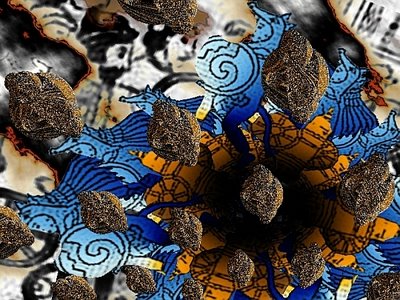
Um dos livros mais deslumbrantes que li foi "La Verdadera Historia de la Conquista de la Nueva España", de Bernal Dias del Castillo, um soldado de Cortez, o destruidor do Império Asteca. Bernal escreveu a obra para solicitar uma pensão ao Rei. A pensão nunca foi concedida e o soldado-escritor morreu na miséria.
A leitura do livro me consumiu quatro meses através da sua intricada sintaxe. A destruição do grande Império Pré-Colombiano foi consumada depois de dois anos de guerra total.
A visão da cultura Asteca foi truncada pelos conquistadores. Até hoje todos os povos pré-colombianos são vistos como cruéis, sanguinários, talvez pela prática de sacrifícios humanos para seus deuses. Como se as fogueiras da Inquisição cristã fossem mais brandas. Bernal Dias del Castillo afirma haver visto 6.000 crâneos humanos expostos num templo. As escavações arqueológicas nunca encontraram semelhante quantidade de restos humanos agrupados em locais de sacrifícios. E quando lemos os poemas escritos por anônimos escritores astecas percebemos uma sensibilidade que transcende a "monstruosidade" que os conquistadores pretenderam inculcar aos vencidos.
La Flor y el Canto
Brotan las flores, están frescas, medran,
abren su corola.
De tu interior salen las flores del canto:
tú, oh poeta, las derramas sobre los demás.
Ou este outro poema, dotado de uma qualidade afetiva que nos parece tão próxima:
Mi hermano el hombre
Amo el canto de zenzontle
pájaro de cuatrocientas voces,
amo el color del jade
y el enervante perfume de las flores,
pero más amo a mi hermano: el hombre.
Transcrevo um trecho do poema que narra os últimos instantes da derrota Asteca e o final deste povo. Embora escrito sete anos após o genocídio, podemos deduzir que o poeta anônimo deve ter presenciado aqueles tremendos acontecimentos. E igualmente podemos perceber uma intensidade dramática que a iguala aos maiores momentos da lírica épica em todos os povos.
Con suerte lamentosa nos vimos angustiados.
En los caminos yacen dardos rotos:
los cabellos están esparcidos.
Destechadas están las casas,
enrojecidos tienen sus muros.
Gusanos pululan por calles y plazas,
y están las paredes manchadas de sesos.
Rojas están las aguas, cual si las hubieran teñido,
y si las bebíamos, eran agua de salitre.
Golpeábamos los muros de adobe en nuestra ansiedad
y nos quedaba por herencia una red de agujeros.
En los escudos estuvo nuestro resguardo,
pero los escudos no detienen la desolación.
Hemos comido panes de colorínhemos
masticado grama salitrosa,
pedazos de adobe, lagartijas, ratones
y tierra hecha polvo y aun los gusanos...
Comments